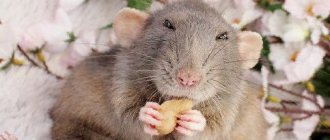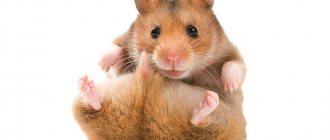Every owner of a decorative rodent is primarily concerned with the question: what do hamsters eat? If you decide to get a furry friend, ask what you can feed him. Small rodents are omnivores and will eat or hide in the pantry everything that catches their eye. Some owners feed their pets what they eat themselves. But this is very harmful for rodents. With such nutrition, the animal will not live long, very soon it will begin to have stomach problems, and everything will end sadly. To prevent this from happening, you need to know what you can feed your hamster, and what it is strictly contraindicated to give it.
What does a rodent eat in nature?
In the wild, the animal’s diet depends on its habitat. These are mainly grain crops, so rodents live, mainly in fields. In drier areas there is more dry food, in wetter areas there is more lush grass, leaves and other greenery. Rodents often raid places where grain, vegetables and other products are stored in rural houses and dachas. Rodents replenish their protein reserves by eating beetles, spiders, worms and caterpillars. They do not disdain the meat of another wounded small animal.
What does a hamster eat at home?
The basic rule to follow when feeding your pet: you can give everything that he can find while living in the wild. The more natural products there are in an animal’s diet, the better for it.
The main types of foods to feed your hamster at home.
- Cereals - wheat, oatmeal, buckwheat, barley, corn. They can be given as whole grains, flakes, or as a porridge cooked in water. Sunflower and pumpkin seeds. Legumes, except red beans.
- Vegetables. Raw carrots, zucchini, pumpkin, bell peppers, eggplants, radishes, radishes. You can also give vegetables boiled without adding salt. It is better to lightly boil beets, broccoli, and cauliflower.
- Greenery, grass, tree leaves. Parsley, dill, lettuce, plantain, young nettle, clover. Young tree branches (apple, pear, birch, maple).
- Fruits and berries. Apples, pears, bananas, cherries, cherries, strawberries. They readily eat rose hips and currants. They love dried fruits (raisins, dried apricots, prunes, pieces of dried apples and pears). Occasionally you can give plums, apricots, and grapes. It is better to remove the seeds.
- Dairy products (low-fat and unsweetened kefir, cottage cheese, natural yogurt).
- Eggs, chicken, fish. Twice a week you can give a boiled egg, a piece of boiled lean chicken or boiled fish. Cook without salt and spices.
- It is better to buy bugs, worms and special insects at a pet store. Hamsters love earthworms, but if you dig them up in a flower bed, you can give your pet an infection.
Pet stores sell dry food for hamsters. It contains essential vitamins and minerals. Try different mixtures to find a food that your pet likes. Such pet food companies as Little One and Vitacraft have proven themselves well.
Food for Dzhungarik
If you ask a veterinarian or pet store employees about what is best to feed your Djungarian hamster, you will almost 100% likely hear about ready-made grain mixtures. Most owners choose them because their composition is carefully thought out by specialists: they contain the required amount of proteins, fats and carbohydrates, and are also enriched with a vitamin complex.
Before purchasing, make sure that you choose food designed for dwarf hamsters. It is unacceptable to offer food for cats, dogs, hares or other rodents.
Then the buyer has to choose:
- grain feed, which consists only of cereals;
- combined, which includes nuts, dried fruits, vegetables and berries.
Typically, ready-made mixtures for Djungarian hamsters contain corn, seeds, oats and crushed nuts. One package lasts approximately two months. If desired, you can supplement the food with approved dry ingredients.
How much do pet hamsters eat?
Your pet is a nocturnal animal, you need to remember this. During the day he sleeps, and at night he eats, plays, exercises on a “simulator,” stores supplies, and sharpens his teeth. Therefore, the best option is to feed the baby twice a day. In the evening - the main meal, a hearty breakfast. In the morning, before bed, have a light dinner.
The amount of food that should be given to an animal at one time depends on the type and size of the rodent. When feeding twice a day, the Syrian is given one tablespoon of the feed mixture, and the Djungarian is given one teaspoon. Campbell's hamsters and other dwarf species feed similarly.
He will hide all the food that the hamster does not eat at one time in the pantry “for a rainy day.” Periodically review these supplies and remove perishable foods so that the animal does not get poisoned. Be sure to put something fresh in place of the “seized valuables”. Otherwise, the baby may become seriously stressed because all his reserves have disappeared, and he will die of hunger in the long, cold winter.
What do dwarf hamsters eat?
Feeding Djungarians is practically no different from feeding Syrian hamsters, with one exception. Children are susceptible to diabetes. For this reason, hamsters should not be given sweet fruits as their main diet. It is better to limit yourself to rare cases and give such fruits in small quantities.
How and what do rodents drink?
If there is a large amount of fresh, juicy vegetables, fruits and herbs in the diet, the homa may drink very little or not drink at all. For example, cucumbers are 90% water. However, there should always be fresh water in the cage. The water in the drinking bowl should be changed at least once a day. If debris from the cage gets into the water bowl, the water must be changed immediately so that the animal does not get poisoned. There are several types of special closed drinkers on sale that prevent tipping over and contamination of the water in the container.
Vitamins for pets
Store-bought mixtures for hamsters contain all the necessary vitamins and microelements. However, in some cases it is necessary to introduce them artificially in order to protect pets from the development of infectious or viral diseases.
Vitamins for hamsters are an important component in their diet.
Vitamin complexes with different compositions are available for sale. However, you cannot choose them yourself without first consulting a veterinarian. The specialist will advise the appropriate complementary foods and dosage based on the age and condition of the pet’s body.
What fruits can pets eat?
Fruits that hamsters eat at home should be fresh and ripe, but without rot. It is better if it is local and seasonal fruits. Citrus and various tropical fruits should not be given. The bones must be pulled out so that the baby does not choke. Sour fruits are contraindicated.
If you are training a baby or teaching him, for example, to use a running wheel, you need to stock up on “goodies.” Sunflower seeds or cookies are suitable for this purpose. Sometimes you can feed your baby a banana. But since rodents constantly need to wear down their teeth, they must eat more solid food. In addition, bananas contain a lot of sugar.
Repeat “fruit” days no more than 1-2 times a week.
Various goodies
Grocery stores offer a variety of treats for hamsters. But before purchasing such food, you should make sure that there is no salt, sugar, flavor enhancers or flavorings in their composition. Such additives are a slow poison for rodents. Therefore, it is better to give preference to the following foods:
- Nuts.
- Banana chips.
- Dried fruits and dried vegetables.
- Sunflower seeds.
Sunflower seeds are a treat for your pet hamster.
What do little hamsters eat?
If everything is fine with the mother, the cubs usually do not need additional food. But if for some reason the babies are left without a mother or she refuses to feed them, you will have to feed the babies using a pipette or a painting brush. Buy a special formula for newborns at a pet store and dilute it to the consistency of milk. Newborn babies should be fed every two hours, then gently massage their tummies to improve digestion. Small hamsters need to be provided with a bottle of warm water (not higher than +31 °C).
At the age of two weeks, you can already give baby formula (Gerber, Agusha), thin porridge with water and without sugar, crushed cottage cheese, egg yolks and fresh herbs.
From three weeks you can give pureed “adult” food. As a rule, at this age babies can already eat on their own.
Pregnant and lactating hamsters need more protein foods.
List of prohibited products
What is strictly forbidden to feed a hamster:
- spicy, salty, smoked and canned foods;
- any spices;
- citrus and exotic fruits (lemons, oranges, tangerines, grapefruits, avocados, etc.);
- onion garlic;
- cabbage;
- potato;
- watermelon;
- mushrooms;
- sweets.
The list of prohibited herbs includes cereal leaves and dandelion. The sharp serrations on these leaves can injure your hamster's cheeks. Dandelion should not be given because of the milky juice.
Canned food
Canned food cannot be fed to domestic rodents, because they contain harmful sugar, salt, hot vinegar and spices. In addition, some preparations are very fatty (vegetable caviar, winter salads).
Under no circumstances feed your furry friend canned and fried vegetables, jams and compote berries. At best, such food will upset digestion, at worst, it will provoke a stomach ulcer or the appearance of tumors.
Fresh fruits will help strengthen the hamster’s body, preserve its eyesight and the beauty of its fur. However, a balance in nutrition should be strictly observed: vegetables should be given along with animal food and dry food, and not instead of them. It is important to keep food fresh and wash it before putting it in your hamster's bowl.
Hamster's daily diet
When choosing what to feed your pet, try to ensure that the food is varied, balanced in composition, and contains vitamins.
| You can give | Not recommended | Forbidden |
| Dry food mixtures for hamsters | Food for other animals or birds | |
| Cereals | Rice (can be given only for diarrhea, well boiled beforehand) | Pasta |
| Vegetables (raw or cooked) | Potatoes, cabbage, onions, garlic | |
| Fruits | Watermelons | Citrus fruits, kiwi, mango, persimmon, pineapple |
| Greens: parsley, dill, lettuce, clover, young nettle | Sorrel, lawn grass, strong-smelling herbs and spices | |
| Sunflower, melon, pumpkin seeds | Watermelon seeds | |
| Nuts | Almonds, acorns, apricot and cherry pits | |
| Wheat sprouts, oats, alfalfa | Bread (black and white), muesli, drops for animals | |
| Legumes | Red beans | |
| Homemade dried fruits | Store-bought dried fruits | |
| Leaves and branches of deciduous and fruit trees | Needles, branches of coniferous trees |
Animal protein is necessary for complete nutrition of a rodent. It is found in the following products:
| Can | It is forbidden |
| Boiled lean chicken meat (breast) | Boiled and smoked sausages, frankfurters, sausages, lard, ham, etc. |
| Yogurt and low-fat cottage cheese (1% fat) | Cheese, sour cream, homemade cow and goat milk, butter |
| Chicken and quail eggs | Honey, ice cream, mushrooms, fruit juices |
| Boiled lean fish | |
| Grasshoppers, butterflies, mealworms purchased at a pet store | Earthworms and other worms from a flower bed or summer cottage |
| Gammarus (dry crustaceans), also sold in stores |
Do not overfeed the animal, do not put more food in the feeder than the prescribed amount. Otherwise, your pet will quickly gain excess weight. Better buy him toys and a running wheel so that he moves more and does not suffer from obesity.
If you liked the article, leave a review. Write to us what else you would like to know about your little pets.











